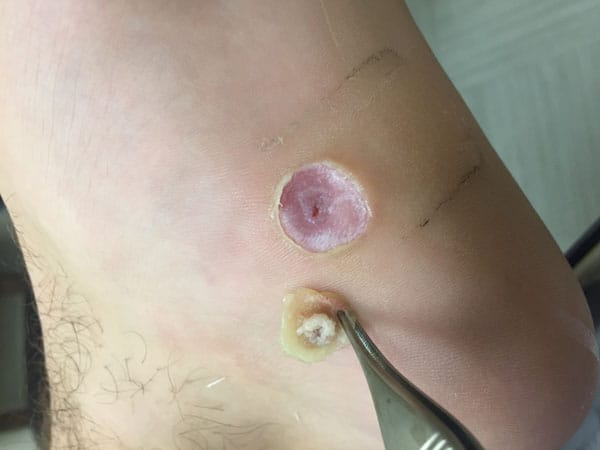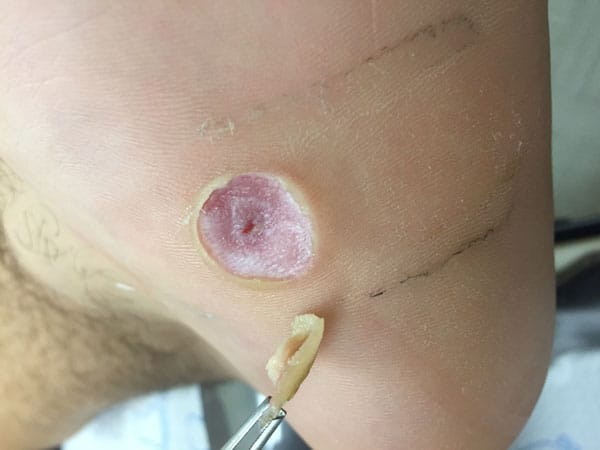Plantar Warts
What are Plantar Warts? A plantar wart is a skin growth most commonly found on the bottom of the feet in teens, children, and the elderly that is caused by a virus infection – HPV (human papillomavirus). What does it look like? A solid grainy (bumpy) growth that appears on the bottom part of the ball of the foot, heels, and toes, especially in areas that experience pressure.
Preferred Foot & Ankle Specialists
Plantar Warts can grow inward due to pressure: beneath a hard and thick layer of skin (callus area). Even though with time this infection may clear up on its own, a majority of patients desire faster relief. The main aim or treatment option available is to remove them completely. Read more about symptoms, causes, and treatment options for Removal of a Plantar Wart.
Symptoms, Causes, Treatment for Plantar Warts
Plantar Wart Symptoms
- Small rough grainy growth (color may be white, grey, tan) located at the bottom of the foot.
- If it is growing inward, they tend to be hard, and they are located at the Callus.
- Black pinpoints can be seen, (mainly known as Wart Seeds). They look like clotted blood vessels. For this reasons, they are commonly known as Seed Warts.
- They interrupt the normal lines and ridges of the foot’s skin.
- They tend to cause pain, tenderness while walking, or standing.
When Should You See A Doctor?
At times, they could lead to severe infections, which will require you to see a podiatrist that specializes in foot care. You should consider consulting your foot doctor if:
- The lesion is painful, changes color or its appearance.
- You have tried treating it but it is has all been in vain. (We don’t suggest self-treatment remedy)
- The condition persists, recurs or multiplies.
- The wart affects your daily activities.
- You have a reduced sensation in your foot, diabetes, or any other severe medical condition.
- You have a weak immune system due to HIV/AIDS, Immune-suppressing Drugs or any other immune system condition.
- You’re not sure if the growth or lesion is a plantar wart.
What Causes Plantar Warts?
Plantar wart (scientifically known as Verruca Plantaris) is caused by an infection related to the human papillomavirus located on the outer layer of the skin. Due to wart’s position, one is going to feel pain when pressure is applied while they are either standing or walking. The virus will enter the body through breaks, cuts or any other weak spot at the bottom part of the feet.
Lesions can appear in single (one) or cluster (many) – known as mosaic warts. If they appear in the cluster (mosaic warts), treatment becomes a bit more difficult to treat and remove them.
How Is The Virus Transmitted?
Just like it is with any disease or health condition, different people react differently to HPV. As such, it is important to note that not everybody who comes into contact with the virus will develop wart. At the same time, some will develop severe problems when they come into contact with the virus. Therefore, it is important to note that every person will react differently to the virus even those in the same family.
It is also important to note that HPV that causes Plantar Warts are not contagious. Therefore, the virus is not easily transmitted through direct contact from person to person. The virus flourishes in warm, moist environments. You may contact the virus through walking around in public locker rooms, showers, or swimming pools. If the virus spreads from one part that has been infected, more warts could appear.
Someone cannot be infected if the virus has no point of entry. For the virus to get into your body, the skin must have a point of entry. It could enter your skin if:
- Dry skin cracks in your feet
- Scrapes and/or cuts
- Soft, wet, fragile skin from being in the water for a long time.
Plantar Wart Treatment, Tests and Diagnosis
Diagnosis, Tests – using one or any of the following:
- Examination and tests
- Checking for signs of dark pinpoint dots
- It is looks abnormal, removing a small part of the lesion and having it tested and analyzed in a laboratory (shave biopsy).
Plantar Warts Removal
After diagnosis by your podiatrist, the next course of action is treatment. If the condition is painful, your foot doctor will schedule an appointment or start treatment right away. The truth is that some warts go away without the need of treatment. However, the only limitation is that it will take a year or several years depending on your immune system to go away. At the same time, rather than them going away by themselves, it may spread to other areas causing more pain. Note – You could require repeated treatments before they go away. Moreover, they could return later.
Conservative Treatment for Removing Warts
Dr. Jarman is very conservative with wart removal and treatment options and elects not to cut or burn (freeze) them out. His preference is to use Cantharidin, a topical treatment that provides little discomfort with application and is very successful. This method works great for children and squeamish adults.
We included a few clinical images taken by Dr. Jarman of a patient’s foot (two weeks after application of Cantharidin) that show exactly how deep warts go into the skin. This method of treatment is very successful compared to the ineffective over-the-counter products for wart removal.
What is Cantharidin?
Cantharidin is a topical ointment used since the 1950’s to treat and remove warts and benign molluscum skin lesions.
Where does it come from?
The “Spanish fly” blister beetles produce Cantharidin, a blister agent that is harvested for chemical use. The male species discharges Cantharidin when mating, passing the substance to the females that make use of the chemical liquid substance to cover her eggs to defend against any predators.
How does Cantharidin work?
Cantharidin (a blistering agent) works on the epidermis (your skin’s outer layer) cell membranes. With a topical application, it causes a blistering effect to breakdown the top layer of the skin cells to get to the wart. The blister in turn causes the tissues that contain the plantar wart virus to separate away from the skin. For this reason, with proper use the area usually heals without scarring.
After Cantharidin Treatment: If changes or response to treatment is not observed by the doctor, further analysis may be required. In this case, the doctor may use a biopsy to rule out other potential causes for the growth. No matter what the treatment approach used, it is paramount to follow the doctor’s instructions. It may include home care medication and treatment. If the condition persists, consult your foot doctor again, because it could be another problem.
CAUTION – With many home treatment and over-the-counter products, it is important to know that DIY home remedies have not been proven, are usually ineffective, and others could be dangerous. If you have warts on your feet, see your local podiatrist or foot doctor. You should NOT consider removing them yourself.
Risk Factors and Complications
The Risks – Anyone is at risk of developing plantar warts. However, it mainly affects:
- Teenagers and children
- Persons with weak immune system
- Those that have had plantar warts before
- Those that walk barefoot in areas where wart-causing virus is common like in public showers.
Complications
If you get a plantar wart, and it is causing you pain, you could unknowingly change your normal gait or posture which could lead to muscle or joint discomfort while standing or walking.
Prepare for your Appointment
Preparing for a Doctor’s Appointment In Advance
If you have decided to seek medical consultation, it is important to prepare. Dr. Jarman may ask the following questions:
- When did the lesion first appear?
- Has it changed in size or appearance?
- Is it painful?
- Have you had warts before?
- Do you have diabetes, poor sensation or any other weak immune related condition?
- Have you tried any home remedies? If so, what and for how long?
- Do you use a public pool or shower rooms at school, the gym or spa?
What to Do
Have a list of all medication you often use including those over-the-counter types such as dietary supplements or nonprescription medicines. Do not forget to include your daily dosage.
Consider wearing well-cushioned shoes, such as athletic shoes to support your weight evenly. This helps in relieving pressure and pain.
Preferred Foot & Ankle Specialist, Dr. Mikkel Jarman, DPM, Phoenix Podiatrist specializes in treating children’s feet, providing gentle treatment and outstanding foot care for you and your kids.
Call our office (480) 497-3946 if you wish to make an appointment or have questions.
Prevention Tips
Learn how you can prevent and reduce the risk of getting this virus or being infected. Consider the following tips.
- Avoid direct contact with the lesion (to prevent it from spreading on your foot)
- Keep your feet dry and clean
- Change your socks and shoes daily
- Wear sandals or water shoes around the swimming pool or at any public shower
- Never pick your wart – it could spread the virus
- Do not use the same pumice stone that you have used around the infection
- Use a disposable emery board to prevent spreading the virus
- Clean your hands thoroughly after touching your feet






